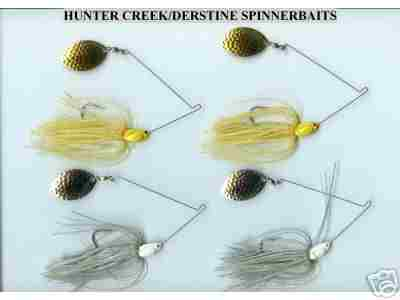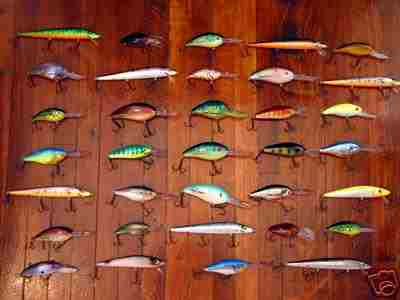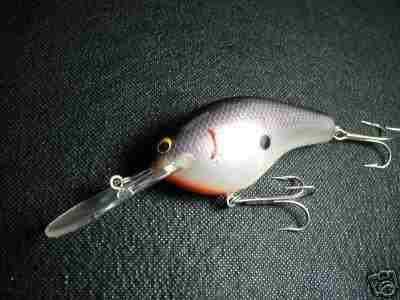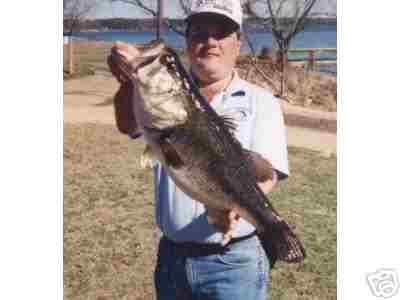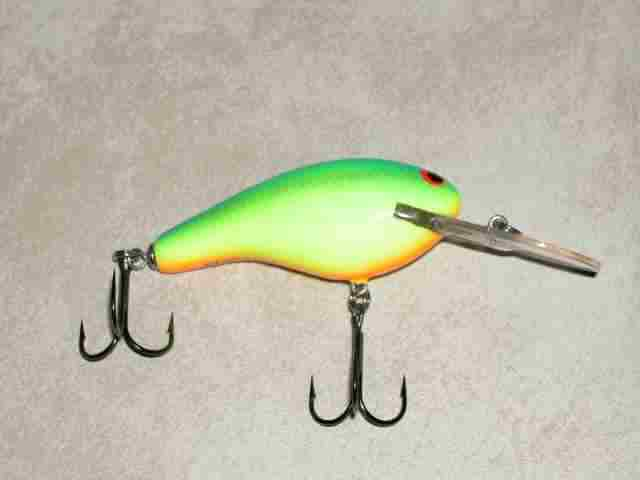Search
Latest Articles
CRANK BAITS FOR ALL SEASONS
by Bruce Middleton, March 06, 2005
Crank baits are bass locators and cover a lot of water in a short amount of time. They work in all weather conditions and all year round. Whether your on your favorite lake near home or far away on a new lake you’ve never fished before, a crank bait will tell you where the bass are and what mood the bass are in.
The main key to locating bass is depth. This fundamental fact must be understood first before all else. The depth at which bass are located is the depth you will catch bass. Sounds simple enough but many bass angles simply don’t realize that if they catch a few bass in 12 feet of water and they move to a different part of the lake they must continue to fish at 12 feet in order to sustain the catch. All too often they fish at whatever depth they are in relative to the distance they have maintained from shore as before. This is totally wrong. I’d say it’s safe to say that well over 80% of the recreational bass fishermen I’ve seen maintain a distance of 15 to 20 yard from the shoreline and never vary from that distance throughout the day. This makes for very erratic catching patterns and often leads to great confusion as to what they have and have not done right or wrong when the days fishing is complete.
Say you have located, with your crank bait, bass holding in about 15 feet of water. If you maneuver your boat so as to constantly stay in 20 feet of water and cast into shore to cover the 12 to 18 foot range, you will greatly increase your success rate, numbers of bass and the size of those bass. Then when moving to any part of the lake, you maintain that depth, you will continue that success.
So, lesson one with a crank bait is: once located, stay there (depth wise).
There is a school of thought that states that a crank bait is a search bait only, and once the bass are located, you should switch to worms or other slower baits to fish for the bass. I disagree! While this theory does have its followers and its applications, a crank bait found the bass and the same crank bait will continue to draw strikes. The beauty of crank baits is that they can be fished with a vast variety of retrieves and speeds to change the look and perception of the lure.
Then there is the process of fine-tuning the lure you originally found the bass with in the first place. Fine-tuning is the practice of making minor changes in the color, size, shape and sound of the crank bait to maximize its effectiveness. The idea is to tune the basic lure until you have the perfect presentation for that day, that hour, which the bass just can’t resist. They don’t just strike the crank bait, they try to crush it. When you have the crank bait fine tuned just right, you will have to hang on to the rod with both hands every time you cast for fear that a giant bass will rip the rod right out of your hands. When you select what lure to use that day, try to think what would be on a bass’s menu. It’s the ability to choose and present lures properly that separates good fishermen from great fishermen. Point in fact. While fishing a lake I was using a 5-3/8 inch minnow shaped crank bait made of plastic with a slightly wide wobble to it. Bass would follow the lure but wouldn’t strike it. By switching to a wooden model the same size and color with a slightly tighter wiggle I caught 30 bass. This tiny adjustment was the difference between no fish and a great number of fish. By taking note that the bass were interested in the lure, showed me I was doing something right but something was off, because the bass weren’t biting. Possible changes you can make are size, color, shape or action. In this case I chose action and went from a wobble to a wiggle and it worked. This fine-tuning of your presentation is all-important. Never think that you are doing things wrong, rather think that you are doing some things right and you just need to fine-tune it to make it perfect. A negative attitude will ruin any activity. So stay positive.

The popularity of crank baits is evident in the staggering selection available to us in catalogs and sports shops. Crank baits, by far, take up the most wall space and catalog pages of all the lures. Short, long, shinny, fat, deep diving, shallow, suspending and floating. Every size, shape, color and noisemaker you can think of. And the best part of it all is, all them work at one time or another.
Because of weather, time of day, light levels, wind, waves, temperature and so many other factors, no crank bait has an edge over any other crank bait, but mainly crank baits are popular because they perform over a wider range of conditions than other lures. The wider the range of conditions a crank bait can perform over the more likely you, as a fisherman will use it. These crank baits soon become confidence lures because you rely on them to catch bass when all else fails or they are the first lures you tie on to start the day.
The only problem with confidence baits is over use without proper care. Since you use these lures all the time, it’s necessary to keep the hook(s) sharp and all the other parts in good working order. There is no excuse for dull hooks. If you’re favorite lures start to let you down, you may look to see if you have let them down with simple neglect.
Not all crank baits are created equal. If you take 6 crank baits of the same type, size and color, one of them will catch more bass than all the others put together. For some reason, the vibration pattern, hook attachment, lip curvature and other minute factors, will make one of these identical crank baits better than the other five. There is no telling from the exterior, or by x-raying them which one it will be. But one will have that perfect fit, that perfect combination of factors that will make it a champion. This is just one reason why, if you buy a crank bait and it doesn’t produce for you, you shouldn’t write off the whole series of lures. You may simply have gotten one that wasn’t perfect. When you do find one that is perfect, mark it, so you identify it readily from the rest.
Those that don’t measure up to perfect can be fine tuned by modifying several parts of the lure. Changing the hooks is a simple task; even changing the size of the hooks can modify the lures action. Sharpening the lip of the crank bait will make the crank bait dive quicker. Adding weight to the lure in various places will completely change the characteristics of the lure. My feelings are this; if the lure doesn’t catch bass for you, tinkering with it can’t hurt a thing and may actually give you a lure that is worth something. That and it gives you something to do on those rainy winter days when you’re just dinking around in the tackle box.
Crank baits, have for too long been taking a back seat to plastics. With the sear diversity of types and styles of crank baits, they should command the front line of your fishing arsenal and not something you toss in the water when all else has failed. Crank baits can be crashed into structure to draw reaction strikes or dragged along the bottom to imitate a crawfish. They can readily imitate any prey fish and look like live prey. Fat bodied wide wobbling crank baits imitate Blue Gill. Prey fish crank baits can be fished year round and account for 1/3 of the entire lures that bass fishermen own. Tight wobbles in cold water and wider wiggles in warm water mimic real fish. The various retrieve styles from stop and go, steady retrieve, fast, slow, medium, twitch retrieve and combinations of these lend versatility to the crank bait. Surface lures, mid water column, shallow diving and deep diving crank baits cover the depth range of any lake. There is nowhere a crank bait can’t go.
Popular weights of crank baits range from ¼ to 1 ounce with 3/8-ounce models being among the most popular. Lengths vary with the model but 1-3/4 inch to 5-1/2 inch are very common. More popular colors are silver, silver/black, black, fire tiger, shad, Tennessee shad, crawfish colors, perch colors, bone, greens, oranges and gold’s. Patterns consist of bold prints for dingy waters and subdued patterns for clear water.
Of all the choices out there you can boil the crank baits down into four distinct groups. There are many brands of each and many variations on a theme, but the four are Lipless crank baits, shallow runners, medium runners and deep runners. Top water are not includes as they are in a class all by themselves. However, many runners are floaters and should not be confused with pure top water lures.

As described, lipless crank baits have no lip. The weight of the lure sinks it and you retrieve it whatever speed is appropriate. Most of the time this means to burn the lipless crank just under the surface of the water at a very high rate of speed. The vibrations sent off by a lipless crank bait draws vicious strikes especially when used in areas where it is not commonly used like shallow lake banks and weed beds. Bass become accustomed to frequently used lures but when something new goes by their instincts kick in and the bass react to it immediately. It is also an easy lure to learn how to use since it usually a steady, fast retrieve after casting. It is also not a tiring lure to use for long periods of time.
The three runners can further be broken down into floating, suspending and sinking models. This gives you 9 possible combinations of lures, however, a deep diving floating crank bait is very hard to come by.
Floating and sinking crank baits on the retrieve have the added motion of moving up or down. This dives the lure a yo-yo action as well as side-to-side action. The double action of up and down, and side to side gives the lure an erratic motion that drives bass crazy.
Floating, sinking and neutral buoyant crank baits are all fished differently. Because of there floating habit the retrieves are lure specific. For instance, neutral buoyant crank bait is cast out and reeled in until the lure achieves its maximum depth. From this point on it is twitched and a stop and go retrieve is used. A floating crank bait is good around heavy cover where stopping the retrieve will let the lure slowly float back up to the surface and out of harms way. It can also be used with a stop and go retrieve or a fast and slow retrieve, which gives the lure an up, and down action. A sinking crank bait is used to remain deep or start out deep and stay there with a slow retrieve, which is especially good is cold water Different models of crank baits, even though they may look almost identical, will have a different vibration to them. If you are in the area where you know there are bass, try experimenting with different models and colors. Try different sizes of internal BB’s or none at all. Try a slightly longer or flatter model. Try a softer color or a bolder pattern.

Suspending diver crank baits allow the fisherman to reach a specified depth and stay there for extended periods of time. Twitching is a favorite method of retrieval with these lures. The length of the pauses between twitches is dictated by the mood of the bass. Active bass require short pauses while inactive bass require longer pauses between pauses.

Deep diving cranks are very important. Bass that hold at 15 to 20 feet are seldom fished with a crank bait and that’s a shame because a crank is new weapon at that depth the bass don’t normally see. And since bass get used to certain profiles like a jig or a worm they tend to shy away from them. But a new sound and vibration pattern can really peak their interest. Cranking a reel on these deep diving lures is a real chore but the bright side is they’re heavy and you can cast them a country mile. You may have to rest every two or three casts but the fishing is well worth it especially if your fish finder says there are fish down there. Filing the front edge of a crank bait to a razors edge will make the lure bite into the water more and dive deeper faster. It also gives it a different sound. It is important to be able to find a way to imprint or mark your crank baits with some indication of how deep they dive. This will prove invaluable as the fishing year goes on. When throwing a big-lipped crank bait it helps to sit down and rest the rod on you leg or something so you don’t tire to quickly. The reward for taking all this punishment is a stringer of huge bass. Resting the rod also helps keep your arms ready to snap the rod in a quick hook set instead of being to tired to lift them.
Pot bellied diver crank baits have the profile of a Blue Gill or Shad. Its wide wobble is good for active bass in the summer and lethargic bass in the winter. The bill size and shape determines the depth at which it will dive as discussed earlier. Flat-sided crank baits have an extremely tight wiggle and are good in cold water if moved really slowly. In summer they work well in weeds, as the tight wiggle doesn’t throw the hooks side-to-side catching every bit of vegetation. They actually go through weeds and grass fairly easily. Lipless cranks are popular for their ability to be cast long distances and the great amount of noise they create. Metal-billed crank baits are the deepest divers of the lot. The extra thin lip bites into the water and pulls the lure down deep in a hurry
Crank bait, spinner bait, jig, worm and a top water lure are the five most used lures for bass fishing. The crank bait is always named first for a good reason. Because it should be used first.

Bruce Middleton
bmiddleeton_9900@msn.com
